

Threshing, or thrashing, [1] [2] is the process of loosening the edible part of grain (or other crop) from the straw to which it is attached. It is the step in grain preparation after reaping. Threshing does not remove the bran from the grain. [3]


Threshing, or thrashing, [1] [2] is the process of loosening the edible part of grain (or other crop) from the straw to which it is attached. It is the step in grain preparation after reaping. Threshing does not remove the bran from the grain. [3]
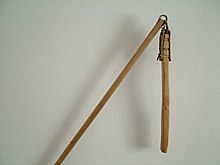
Through much of the history of agriculture, threshing was time-consuming and usually laborious, with a bushel of wheat taking about an hour. [4] In the late 18th century, before threshing was mechanized, [5] about one-quarter of agricultural labor was devoted to it. [6]
It is likely that in the earliest days of agriculture the little grain that was raised was shelled by hand, but as the quantity increased the grain was probably beaten out with a stick, or the sheaf beaten upon the ground. An improvement on this, as the quantity further increased, was the practice of the ancient Egyptians of spreading out the loosened sheaves on a circular enclosure of hard ground, and driving oxen, sheep or other animals round and round over it so as to tread out the grain. This enclosure was placed on an elevated piece of ground so that when the straw was removed the wind blew away the chaff and left the corn. [7] A contemporary version of this in some locations is to spread the grain on the surface of a country road so the grain may be threshed by the wheels of passing vehicles. [8]
This method, however, damaged part of the grain, and it was partially superseded by the threshing sledge, a heavy frame mounted with three or more rollers, sometimes spiked, which revolved as it was drawn over the spread out corn by two oxen. A common sledge with a ridged or grooved bottom was also used. Similar methods to these were used by the ancient Greeks, and continued to be employed in the modern period in some places. In Italy the use of a tapering roller fastened to an upright shaft in the centre of the thrashing floor and pulled round from the outer end by oxen seems to be a descendant of the Roman tribulum or roller sledge. [7]
The flail, a pair of connected sticks used to beat the grain, evolved from the early method of using a single stick. It, with the earlier methods, was described by Pliny the Elder in his first-century CE Natural History : "The cereals are threshed in some places with the threshing board on the threshing floor; in others they are trampled by a train of horses, and in others they are beaten with flails". [9] It seems to have been the thrashing implement in general use in all Northern European countries, and was the chief means of thrashing grain as late as 1860. It was known in Japan very early, and was probably used in conjunction with the stripper, an implement fashioned very much like a large comb, with the teeth made of hard wood and pointing upwards. The straw after being reaped was brought to this and combed through by hand, the heads being drawn off and afterwards threshed on the threshing floor by the flail. Much more recently, just such an implement, known as a "heckle", has been used for combing the bolls or heads off flax, or for straightening the fibre in the after-treatment. [7]
After the grain had been beaten out by the flail or ground out by other means the straw was carefully raked away and the corn and chaff collected to be separated by winnowing when there was a wind blowing. This consisted of tossing the mixture of corn and chaff into the air so that the wind carried away the chaff while the grain fell back on the threshing floor. The best grain fell nearest while the lightest grain was carried some distance before falling, thus an approximate grading of the grain was obtained. It was also performed when there was no wind by fanning while pouring the mixture from a vessel. Later, a fanning or winnowing mill was invented. Barns were constructed with large doors opening in the direction of the prevailing winds so that the wind could blow right through the barn and across the threshing floor for the purpose of winnowing the corn. The flail continued to be used for special purposes such as flower seeds, and also where the quantity grown was small enough to render it not worth while to use a threshing mill.
With regard to the amount of grain threshed in a day by the flail, a fair average quantity was 8 bushels of wheat, 30 bushels of oats, 16 bushels of barley, 20 bushels of beans, 8 bushels of rye and 20 bushels of buckwheat.
In the 18th century there were efforts to create a power-driven threshing machine. In 1732 Michael Menzies, a Scot, obtained a patent for a power-driven machine. This was arranged to drive a large number of flails operated by water power, but was not particularly successful. The first practical effort leading in the right direction was made by a Scottish farmer named Leckie about 1758. He invented what was described as a "rotary machine consisting of a set of cross arms attached to a horizontal shaft and enclosed in a cylindrical case." This machine did not work very well, but it demonstrated the superiority of the rotary motion and pointed to the ways in which thrashing machines should be constructed. [7]
True industrialization of threshing began in 1786 with the invention of the threshing machine by Scot Andrew Meikle. In this the loosened sheaves were fed, ears first, from a feeding board between two fluted revolving rollers to the beating cylinder. This cylinder or "drum" was armed with four iron-shod beaters or spars of wood parallel to its axle, and these striking the ears of corn as they protruded from the rollers knocked out the grain. The drum revolved at 200 to 250 revolutions per minute and carried the loose grain and straw on to a concave sieve beneath another revolving drum or rake with pegs which rubbed the straw on to the concave and caused the grain and chaff to fall through. Another revolving rake tossed the straw out of the machine. The straw thus passing under one peg drum and over the next was subjected to a thorough rubbing and tossing which separated the grain and chaff from it. These fell on to the floor beneath, ready for winnowing. [7]
A later development of the beater-drum was to fix iron pegs on the framework, and thus was evolved the Scottish "peg-mill," which remained the standard type for nearly a hundred years, and was adopted across the US. [7] In Britain, the development of high-speed drums carried considerable risk, and a type of safety guard was mandated by the Threshing Machine Act of 1878. [7]
Today, in developed areas, threshing is mostly done by machine, usually by a combine harvester, which harvests, threshes, and winnows the grain while it is still in the field. [10] [11]
A threshing bee was traditionally a bee in which local people gathered together to pitch in and get the season's threshing done. Such bees were sometimes festivals or events within larger harvest festivals. Today the original purpose is largely obsolete, but the festival tradition lives on in some modern examples that commemorate the past and include flea markets, hog wrestling, and dances. [12] [13] [14]

A threshing machine or a thresher is a piece of farm equipment that threshes grain, that is, it removes the seeds from the stalks and husks. It does so by beating the plant to make the seeds fall out.

Winnowing is a process by which chaff is separated from grain. It can also be used to remove pests from stored grain. Winnowing usually follows threshing in grain preparation. In its simplest form, it involves throwing the mixture into the air so that the wind blows away the lighter chaff, while the heavier grains fall back down for recovery. Techniques included using a winnowing fan or using a tool on a pile of harvested grain.
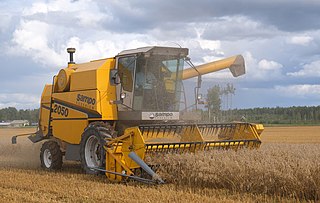
The modern combine harvester, or simply combine, is a machine designed to harvest a variety of grain crops. The name derives from its combining four separate harvesting operations—reaping, threshing, gathering, and winnowing—to a single process. Among the crops harvested with a combine are wheat, rice, oats, rye, barley, corn (maize), sorghum, millet, soybeans, flax (linseed), sunflowers and rapeseed. The separated straw, left lying on the field, comprises the stems and any remaining leaves of the crop with limited nutrients left in it: the straw is then either chopped, spread on the field and ploughed back in or baled for bedding and limited-feed for livestock.

Chaff is the dry, scaly protective casing of the seeds of cereal grains or similar fine, dry, scaly plant material. Chaff is indigestible by humans, but some livestock can eat it. In agriculture, it is used as livestock fodder, or is a waste material ploughed into the soil or burned.

A reaper is a farm implement or person that reaps crops at harvest when they are ripe. Usually the crop involved is a cereal grass. The first documented reaping machines were Gallic reapers that were used in Roman times in what would become modern-day France. The Gallic reaper involved a comb which collected the heads, with an operator knocking the grain into a box for later threshing.

Matthew 3:12 is the twelfth verse of the third chapter of the Gospel of Matthew in the New Testament. The verse occurs in the section relating the preachings of John the Baptist. In this he uses the imagery of harvesting wheat to describe God's judgement.

A flail is an agricultural tool used for threshing, the process of separating grains from their husks.
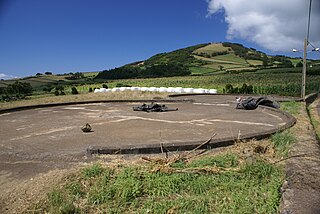
Threshing (thrashing) was originally "to tramp or stamp heavily with the feet" and was later applied to the act of separating out grain by the feet of people or oxen and still later with the use of a flail. A threshing floor is of two main types: 1) a specially flattened outdoor surface, usually circular and paved, or 2) inside a building with a smooth floor of earth, stone or wood where a farmer would thresh the grain harvest and then winnow it. Animal and steam powered threshing machines from the nineteenth century onward made threshing floors obsolete. The outdoor threshing floor was either owned by the entire village or by a single family, and it was usually located outside the village in a place exposed to the wind.

A rice huller or rice husker is an agricultural machine used to automate the process of removing the chaff of grains of rice. Throughout history, there have been numerous techniques to hull rice. Traditionally, it would be pounded using some form of mortar and pestle. An early simple machine to do this is a rice pounder. Later even more efficient machinery was developed to hull and polish rice. These machines are most widely developed and used throughout Asia where the most popular type is the Engelberg huller designed by German Brazilian engineer Evaristo Conrado Engelberg in Brazil and first patented in 1885.
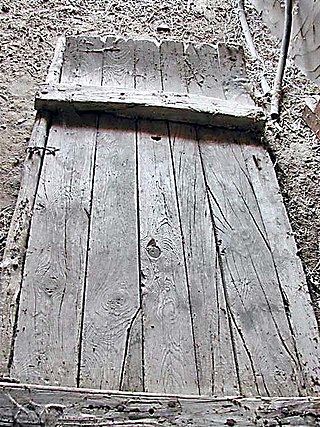
A threshing board, also known as threshing sledge, is an obsolete agricultural implement used to separate cereals from their straw; that is, to thresh. It is a thick board, made with a variety of slats, with a shape between rectangular and trapezoidal, with the frontal part somewhat narrower and curved upward and whose bottom is covered with lithic flakes or razor-like metal blades.

Agricultural machinery relates to the mechanical structures and devices used in farming or other agriculture. There are many types of such equipment, from hand tools and power tools to tractors and the countless kinds of farm implements that they tow or operate. Diverse arrays of equipment are used in both organic and nonorganic farming. Especially since the advent of mechanised agriculture, agricultural machinery is an indispensable part of how the world is fed. Agricultural machinery can be regarded as part of wider agricultural automation technologies, which includes the more advanced digital equipment and robotics. While agricultural robots have the potential to automate the three key steps involved in any agricultural operation, conventional motorized machinery is used principally to automate only the performing step where diagnosis and decision-making are conducted by humans based on observations and experience.
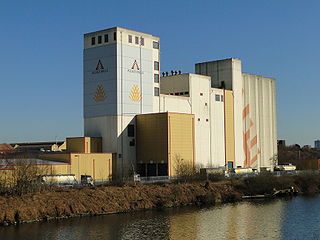
A gristmill grinds cereal grain into flour and middlings. The term can refer to either the grinding mechanism or the building that holds it. Grist is grain that has been separated from its chaff in preparation for grinding.

Malting is the process of steeping, germinating and drying grain to convert it into malt. Germination and sprouting involve a number of enzymes to produce the changes from seed to seedling and the malt producer stops this stage of the process when the required enzymes are optimal. Among other things, the enzymes convert starch to sugars such as maltose, maltotriose and maltodextrines, hence the name malt.

A threshing stone is a roller-like tool used for the threshing of wheat. Similar to the use of threshing boards, the stone was pulled by horses over a circular pile of harvested wheat on a hardened dirt surface, and the rolling stone knocked the grain from the head of wheat. The straw was removed from the pile and the remaining grain and chaff was collected. By a process called winnowing, the grain was tossed into the air to allow the chaff and dirt to be blown away, leaving only the grain.
Wheat is produced in almost every state in the United States, and is one of the most grown grains in the country. The type and quantity vary between regions. The US is ranked fourth in production volume of wheat, with almost 50 million tons produced in 2020, behind only China, India and Russia. The US is ranked first in crop export volume; almost 50% of its total wheat production is exported.
Stripper was a type of harvesting machine common in Australia in the late 19th and early 20th century. John Ridley is now accepted as its inventor, though John Wrathall Bull argued strongly for the credit.
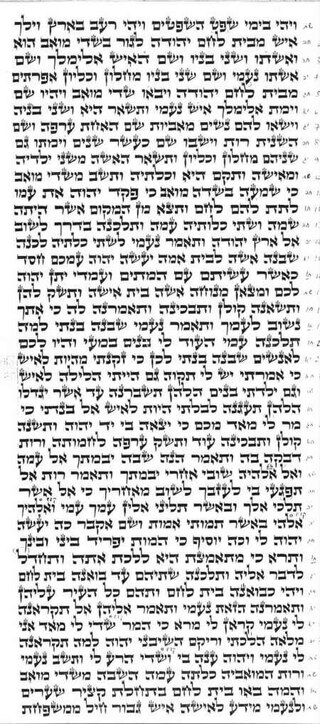
Ruth 3 is the third chapter of the Book of Ruth in the Hebrew Bible or the Old Testament of the Christian Bible, part of the Ketuvim ("Writings"). This chapter contains the story of how on Naomi's advice, Ruth slept at Boaz's feet, Ruth 3:1-7; Boaz commends what she had done, and acknowledges the right of a kinsman; tells her there was a nearer kinsman, to whom he would offer her, and if that man refuses, Boaz would redeem her, Ruth 3:8-13; Boaz sends her away with six measures of barley, Ruth 3:14-18.

The S-4 «Stalinets», is a self-propelled combine harvester, made by several different combine harvester plants in the former Soviet Union, from 1947 until 1955. In 1955, the modernised variant, called the S-4M, was introduced; it was put out of production in 1958. In total, 29,582 units were built. In former East Germany, the S-4 combine was built under licence by the IFA as the Fortschritt E 170 series, from 1954 until 1967. Unlike the original S-4, which is powered by an otto engine, the Fortschritt E 170 series combines were all powered by a diesel engine, and some of them came with a chaff waggon rather than a straw waggon.

The Fortschritt E 162, also known as the LBH 52 Kombinus, is a tractor-drawn combine harvester, made by the East-German manufacturer VEB Mähdrescherwerk Boschofswerda/Singwitz in Singwitz, from 1952 until 1956. In total, 54 were built. The E 162 proved to be an unreliable combine, and it was soon replaced by the Fortschritt E 170 series.
{{cite web}}: CS1 maint: unfit URL (link)